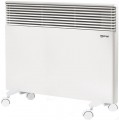Max. power
The maximum power of the heater. The meaning of this parameter depends on the device type and power supply (see above). So, for most types of heaters, we are talking about the highest power output. However, for fan heaters, this parameter also includes the power of the fan motor, and the heating capabilities are somewhat more modest than the claimed maximum power (although not by much). For electric models, the maximum power also corresponds to the maximum power consumption, which determines the connection requirements: for example, for devices of 3.5 kW and more, ordinary sockets are no longer suitable, and some require not 230 V but 400 V.
However, the key point determined by the power of the heater, is the intensity of heating and the ability to effectively heat a particular room. To select the appropriate model, there are special formulas. So, if we are talking about a city apartment or a small office space with a ceiling height of about 2.5 m, then we can assume that a heating power of at least 100 W is required per 1 m² of area. For other situations, more complex methods are used, taking into account the volume of the room, the degree of thermal insulation, climate and solar heating, etc.; they can be found in special sources. Also note that for IR heaters (see "Type"), their own calculation methods are used — this is due to the specific format of work.
Heating area
A very conditional parameter that slightly characterizes the purpose based on the size of the room. And depending on the height of the ceilings, layout and equipment, actual values may vary significantly. However, this item represents the maximum recommended area of the room that the device can effectively heat. This parameter directly depends on the maximum power (see above). It is worth noting that the actual efficiency of the heater in most cases depends not on the area, but on the volume of the room. In light of this, the heating area can only be specified for a certain ceiling height. In most cases, manufacturers mean 2.5 m - this is the standard ceiling height in city apartments. If the ceilings are much higher, the heating area must be recalculated using special formulas. In general, it is worth considering that 1 kW is comfortable for 10 m², however, manufacturers may slightly overestimate the heating area data.
Heating modes
The ability to adjust the power of the heater. Do not confuse this parameter with temperature control since several power modes primarily affect the heating rate, energy consumption and device wear.
Safety system
— Overheat protection. The system of automatic shutdown of the heater when the critical temperature of the heating element is reached (which can happen, for example, if the fan heater motor fails). Ensures the fire safety of the device.
— Waterproof. The presence of a body protected from water splashes (most often sealed). Such heaters can be used in rooms with high humidity — for example, bathrooms — without the risk of short circuits or electric shock. However, even in such models, it is imperative to clarify the specific degree of water protection and restrictions on use before use; these data can be found in the instructions or other official documents of the manufacturer.
— Child lock. The control lock function prevents playful children or animals from changing the settings. Relevant for advanced devices with extensive management capabilities.
— Tip-over protection. A system that turns off the heater when it tips over to avoid fire or damage to the floor. This feature is especially relevant if there are small children in the house.
— Motion sensor. The presence of an appropriate sensor allows the device to focus on the presence of people and, by this, warm up the room. So, the absence of any movement in the "field of view" of the heater puts it into sleep mode. And the detection of movement (be it a dog or a person) reactivates it.
— Open window sensor. A special sensor allows the device to automatically recogni...ze when a window is opened for ventilation. In the process of airing the premises, the heater either turns off completely or switches to the most economical operation mode. This function allows you to save energy because, in the process of ventilation, the room heat will still evaporate into the street. Usually, the heating stop time is up to 30 minutes — in some models, the exact ventilation time can be adjusted by the user. The very fact of ventilation is most often fixed by the electronics. To do this, automation can use either traditional magnetic contact sensors or draft sensors (cold air inflow).

